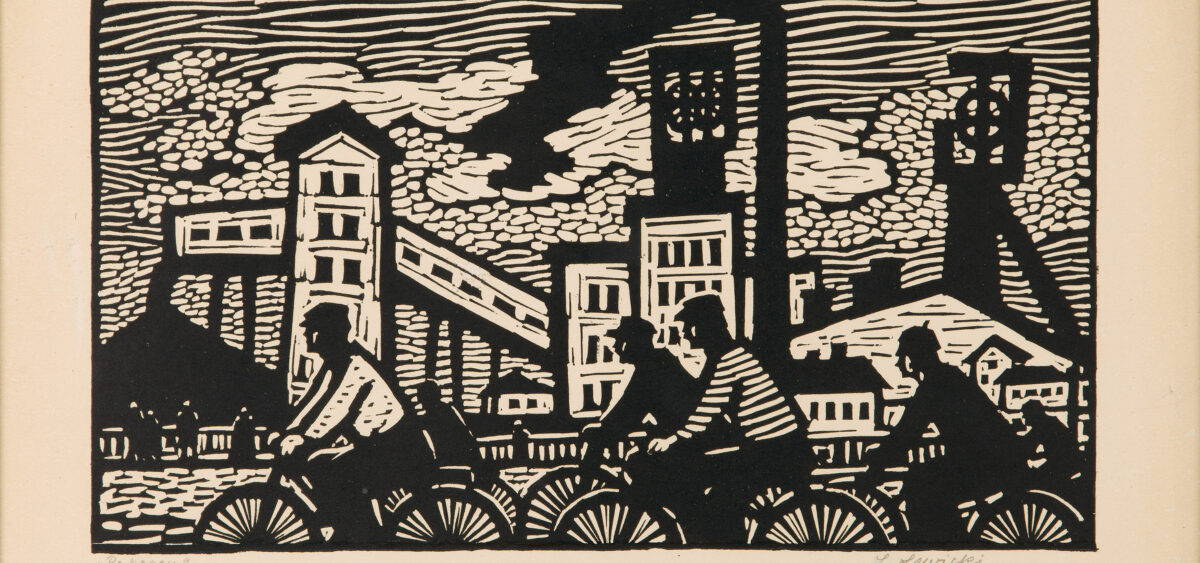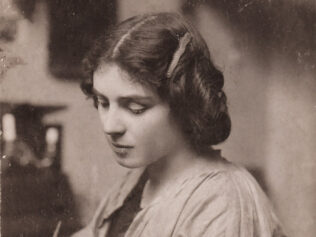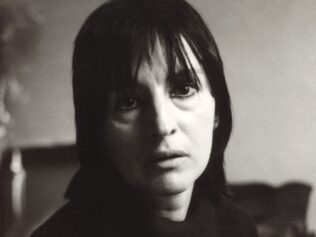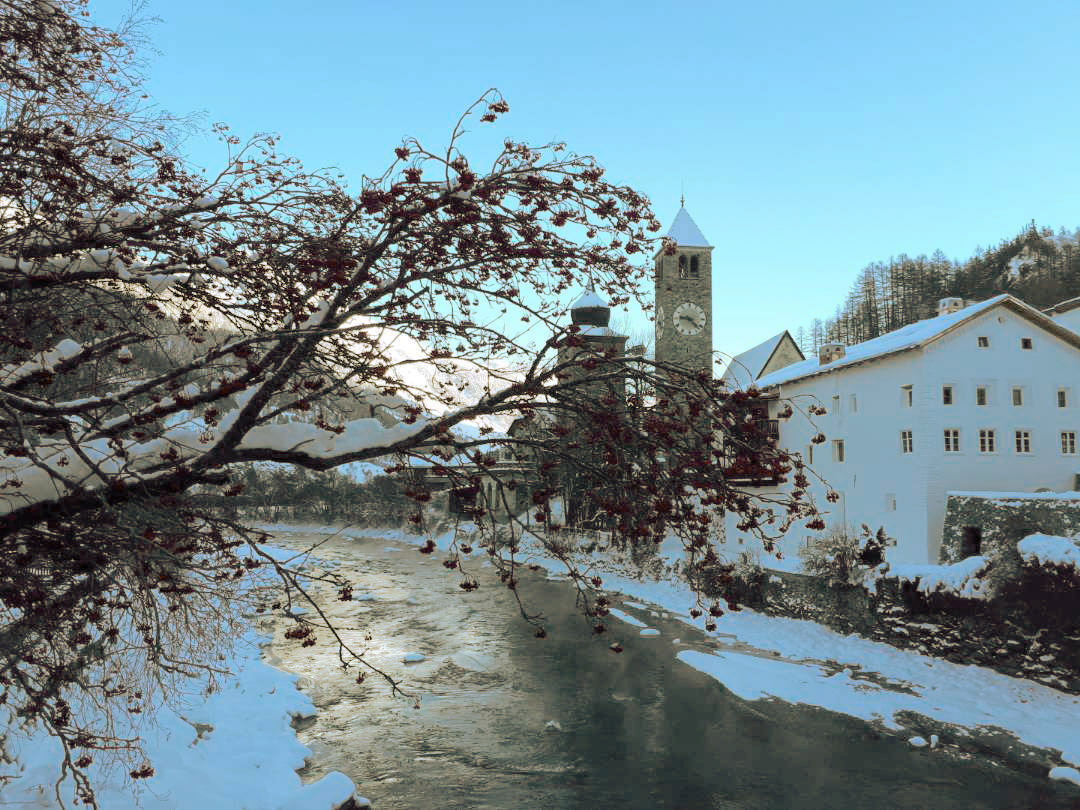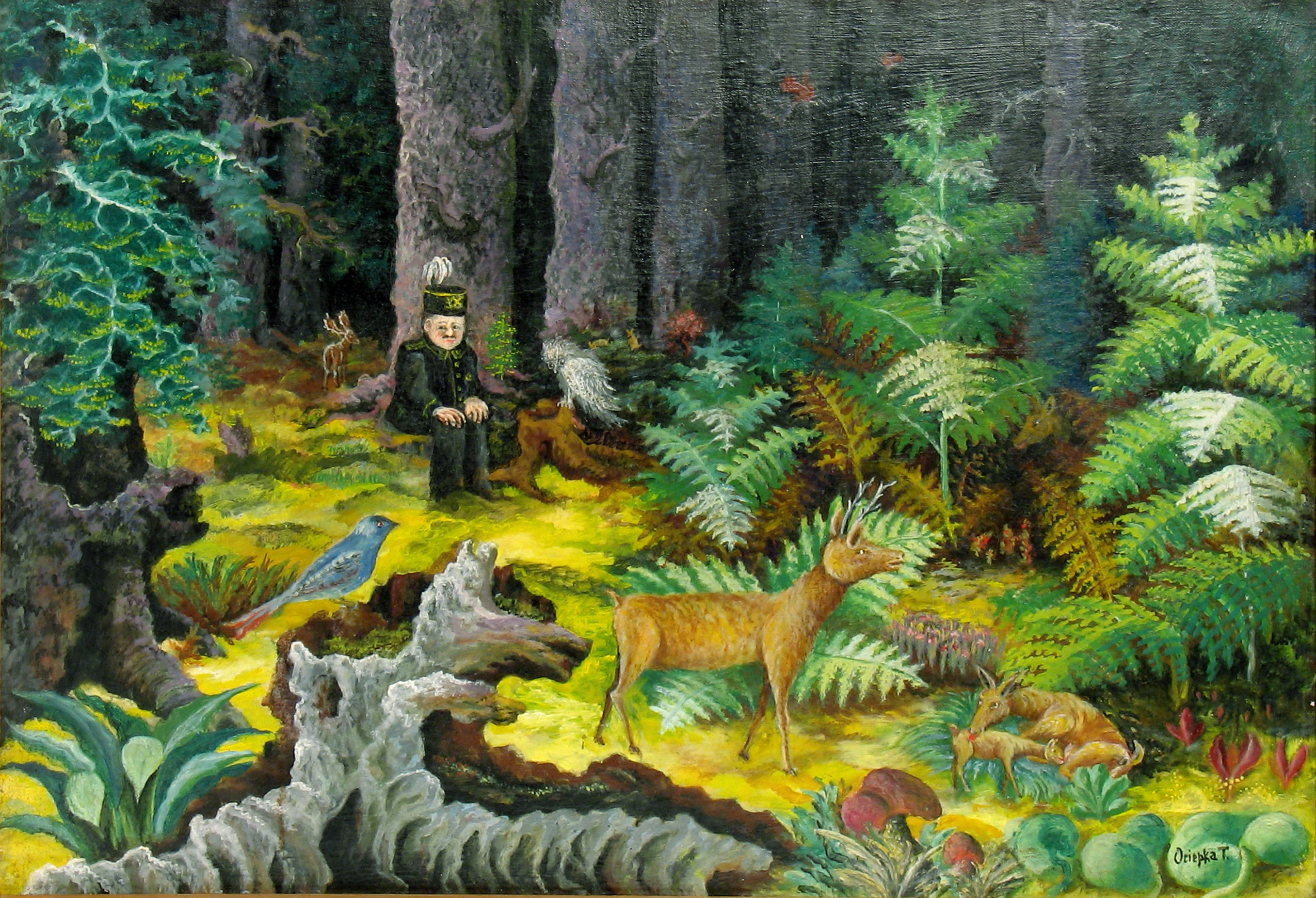
Leopold Lewicki’s talent was immediately spotted by the critics. They appreciated not only his innovative canvases, but also his grotesque prints, stylized to look as if created by a child. One of the critics even compared the artist to van Gogh.
Leopold Lewicki was born on 7th August 1906 in the village of Burdiakowce (modern-day Burdyakivtsi in Ukraine), not far from Czortków (Chortkiv) in the Tarnopol (Ternopil) Voivodeship, where his father Jan Lewicki was a blacksmith in the estate of Count Gołuchowski. Jan later worked as a metalworker in a railway depot, which was quite useful for Lelek – under which name the young Leopold was known – because, as a national railway worker’s family member, he was entitled to free train travel within the borders of the Polish state. Leopold’s mother – Olga, née Bluss – came from a Ukrainian family, and one of his grandmothers was Jewish. As a grown man, Leopold married Henia, daughter of Benzion Nadler from Czortków, and by doing this, he brought together the then three main blood strands of the historic Podolia region (in what is now western and central Ukraine).
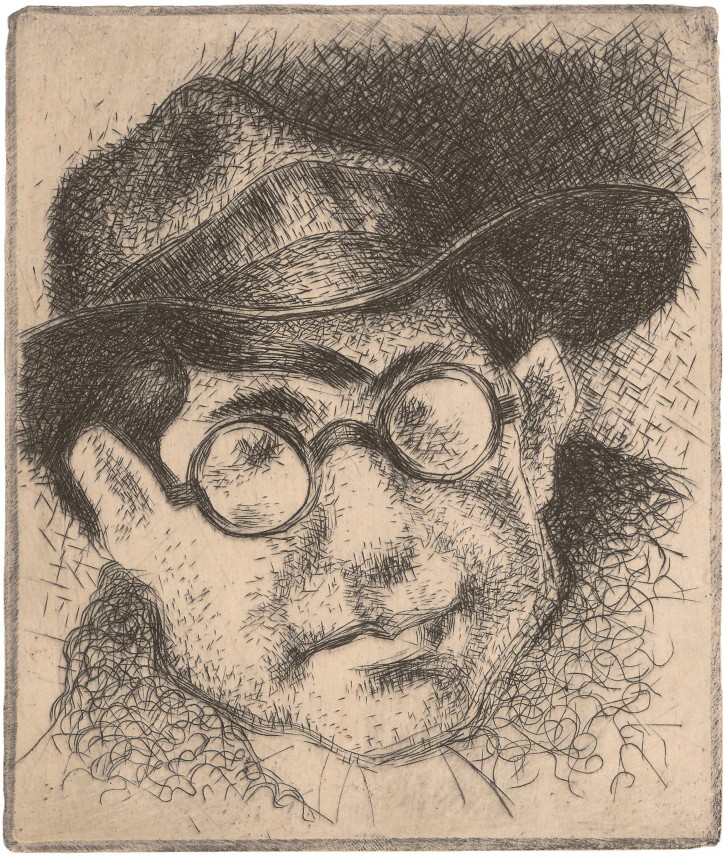
In autumn of 1925, after graduating from the Juliusz Słowacki Gymnasium in Czortków, Lewicki began his studies in Kraków. At first, he enrolled at the Law Department of the Jagiellonian University, but in the end decided to study at the Academy of Fine Arts. He was a student of Władysław Jarocki and Józef Mehoffer. At the turn of 1930 and 1931, he went to Paris to continues his studies under Józef Pankiewicz at the local branch of the Kraków Academy of Fine Arts, established in 1928 by a group of artists, enthusiasts of modern painting, widely known as Kapists (from KP, Polish for the ‘Paris Committee’). However, as early as in spring of 1931, he was arrested during a demonstration at the Communards’ Wall on the Père Lachaise Cemetery, and deported by the French authorities.
Upon his return to Kraków, he continued his studies under the very Chancellor of the Kraków Academy of Fine Arts, Fryderyk Pautsch. Unfortunately, this was not a good time to study art in Poland. In November 1931, some trouble broke out at the campus. Supporters of the right-wing National Democracy movement among the students started throwing out those of their colleagues who didn’t share their patriotic enthusiasm. People protesting against it were forcefully removed from the room and thrown down the stairs. The same fate awaited those defending the protesters. Sadly, the weak and confused Chancellor Fryderyk Pautsch called to account both the aggressors and the defenders of the expelled students, including Leopold Lewicki.
The conflict at the Academy of Fine Arts flared up in June 1932 during the opening of the annual student exhibition. As a result of the arrogant behaviour of the students in the Academy office, Pautsch ordered Lewicki’s and Stanisław Osostowicz’s paintings to be removed from his studio presentation. The situation got exacerbated when both artists attempted to bring their artwork back into the exhibition. To make matters worse, on the very same day, the city authorities informed the Academy that Lewicki’s prints exhibited as part of Jan Wojnarski’s studio display were accompanied by anti-religious and anti-state signage. The Secretary of the Academy, in the presence of a Polish State Police sub-commissioner, removed those prints from the exhibition. Here are their titles, which I provide to demonstrate what the then authorities understood as ‘anti-religious and anti-state’: Bourgeoisie Paradise; Rally of the Communist Party of Poland; The Red Current; In Kraków on 16th June 1932; Disarmament Conference; Questioning of a Pioneer; A Funeral; Offices; Rerum Novarum Encyclical; Female Members of the Komsomol; Proletarian Freedom; The Tax Screw Gets Tightened; Basic Military Training; A Mass Gathering in Front of a Factory; Arise, Slaves Afflicted by Hunger and Cold; and Mystical Christ.
On the very same day, the security services searched Lewicki’s flat in the PKO building at 5 Zyblikiewicza Street, where, on top of the previously-mentioned 16 prints, they also confiscated two sketchbooks filled with Aleksander Winnicki’s drawings from street demonstrations, as well as notes entitled “About the origins of religion” and “About art from contemporary Soviet Russia”. They also took Jonasz Stern’s paper, which began with the words: “The October Revolution has provided the masses with the biggest opportunities.” As a result of this operation, police arrested Lewicki, as well as his colleagues Jonasz Stern, Aleksander Winnicki, Bolesław Stawiński and Henryk Wiciński, on suspicion of communist activity. Lewicki was released from custody on 8th July. On 9th November, he was expelled from the Kraków Academy of Fine Arts, and on 6th December he was accepted as a member of the Kraków Association of Polish Artists and Designers (ZPAP).
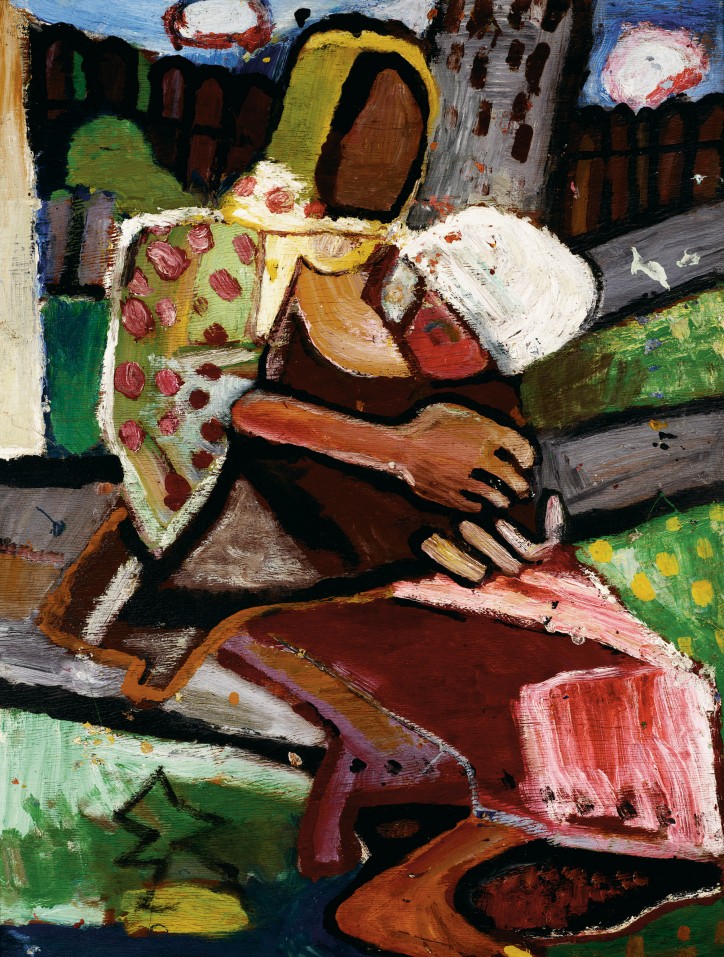
Evidently, the board of ZPAP didn’t share the opinion of Chancellor Pautsch about Lewicki’s merits. This was proven by an exhibition of his works, as well as works of two other students expelled from the Academy – Stanisław Osostowicz and Franciszek Jaźwiecki – in the ZPAP gallery, located in The Cross House at Holy Spirit Square.
Naked matter
Significantly, the opening of the exhibition of works by Jaźwiecki, Lewicki and Osostowicz took place on 13th November 1932, only several days after all three were dismissed from the Academy of Fine Arts. The newly-expelled exhibited over 50 paintings and 15 lithographs. A reviewer from Nowy Dziennik wrote in the 4th December 1932 issue that: “Lewicki exhibits a triptych, a large-scale canvas in which, as he himself says, he introduces new textures by pasting natural elements, such as newspaper cuttings, onto the canvas. This method has been used by Picasso and Braque in their canvases. Lewicki uses it with understanding. Mr Lewicki says that the new means of production breaking into our life in the form of machines have caused a substantial change in his artistic philosophy. Indeed, his paintings have become a technical-engineering effort, a construct of elements of a painting turned into a composition.”
A group of young artists started gathering around Lewicki. They shared his convictions – they were unhappy about what was going on at the Academy of Fine Arts, as well as across the whole country. They were: Henryk Wiciński and Maria Jarema, Stanisław Osostowicz, Aleksander Winnicki, Bolesław Stawiński, Sasza Blonder and Berta Grünberżanka, to name just a few who would soon form the nucleus of the so-called ‘Kraków Group’. Some of them were members of the youth section of the Communist Party of Poland (KPP). Others only felt an affinity with their causes. Soon Lelek developed a very close bond with one particular member of this group, also originally from Podolia – Jonasz Stern. Both were activists of the KPP. Let me quote Jonasz Stern’s recollection: “I remember […] some National Democrats attacking us once. We were walking with Lewicki, he was quite dark-haired and looked like a Jew, though wasn’t one. So they targeted him. He was short-sighted and always wore glasses. His glasses fell off. And he stood there dumbfounded. So I got involved, I punched one on his nose and he was covered in blood. As soon as they saw blood, they ran away.”
In October 1933, the ‘Kraków Group’ held their first collective exhibition at the Society of Friends of Fine Arts in Lwów (modern-day Lviv). Lewicki showed five oil canvases and two textural pieces. The next exhibition of the group was on 27th May 1934 in the Kołłątaj Room at the Krzemieniec Lyceum in Kremenets in Volhynia, where Lewicki presented three oil canvases described by the correspondent of Wołyń magazine as “suprematist compositions”.
The third and last exhibition of the ‘Kraków Group’ took place on 17th February 1935 in the newly-built location of the Kraków Association of Polish Artists and Designers: Dom Plastyka at 3 Łobzowska Street. In a review published by Nowy Dziennik on 1st March 1935, the reviewer describes Lewicki’s works as follows: “The best of them – Lewicki – attracts immediately with his deep understanding of material and his passion for construction, […] he imposes a colour mood of building materials and countryside. And he doesn’t hide behind the illusion of paint, he pastes things directly: clay, straw, plaster, grain and glass. His is a thoroughly visionary construction, coarsely expressed in naked matter.” These works didn’t survive; they were destroyed either by invaders or by local opponents of modern art. We can, however, get some impression of what they were like from a photograph from this exhibition, showing Lewicki’s three textural pieces as well as his Musical Composition.
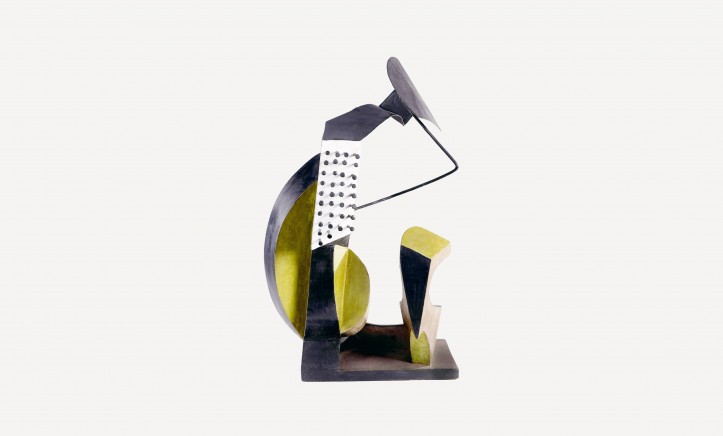
In January 1936, three paintings by Lewicki, accompanied by works by Blonder, Jarema, Wiciński and Stern, were accepted for the exhibition at the Institute of Art Propaganda in Warsaw, as part of the Artists’ Salon organized by the Association of Polish Artists and Designers (Kraków, Lwów, Poznań, Warsaw).
Primitivist and grotesque
Lewicki’s artistic affairs were going well, he was respected by critics and other artists, and there was even a mysterious Scandinavian collector of his works active in Lwów. Yet despite all that, in mid-1935 the artist decided to move back to Czortków. The reason for this decision might have been Henia, daughter of Benzion Nadler and Gołda Gofner, who eventually became his wife. We don’t know for sure. But what we do know is that at the end of that year, Lewicki was arrested as part of an investigation ran in Czortków against members of the Communist Party of Western Ukraine, as well as the Communist Party of Poland. Lewicki spent six months behind bars. Upon his release, most likely helped by the appeal of the Kraków Association of Polish Artists and Designers, he settled for a time in Lwów, on the sixth floor of an elegant building at 4 Fredry Street, in the flat of the photographer Wanda Diamand, well known in the then artistic circles in Lwów. The place was visited by both artists, such as Bruno Schulz, Ludwik Lille, Marian Wnuk, Marek Włodarski and Erna Rosenstein, and writers including Aleksander Dan, Jisrula Aschendorf and Petro Kozłaniuk. It was also frequented by actors of the experimental studio Maska, led by the director Henryk Lotar, as well as progressive academics (mainly mathematicians, such as Władysław Herzberg, Władysław Hepter and Marek Katz).
In January 1937, Lewicki organized one more exhibition together with Stanisław Osostowicz in the Craft Museum in Lwów, which was the then seat of the local Association of Polish Artists and Designers.
This time the critics paid most attention to his prints. “What strikes you initially in the artist’s form is the primitivization, which makes Lewicki’s works look like children’s art. Using not the empirical reality as a basis but the visionary and mnemonic concept of the world, he creates naive and as such attractive and creatively rich forms, shapes full of synthetic reduction.” Or: “Expressive in their grotesque ugliness, Lewicki’s portraits sometimes resemble Grosz’s monstrous figures, and the strong deformation and exaggerated typification of some body parts (Worker) makes one think of Van Gogh’s expressive portraits.”
Even so, the year 1937 was not good, neither for Lewicki, nor for the entirety of Polish art. Already in February, almost 30 members were expelled from the Kraków branch of the Association of Polish Artists and Designers under the pretext of being behind with paying their membership fees. Among them were Blonder, Grünberżanka, Marczyński, Stawiński, Stern, Osostowicz, Wiciński and Lewicki. Lewicki’s request to be readmitted to the Association was denied. Instead, on 1st March, the Kraków branch of the Association “[…] in response to the ideological and political declaration of Colonel Adam Koc joined the Camp of National Unity.” General Rydz-Śmigły became the honorary member of the Association, and Jonasz Stern, in chains, was ostensibly taken from the Academy building to the railway station, and then sent to the detention camp in Bereza Kartuska. At the time, Wiciński was taking medical treatments in Zakopane, while Blonder and Grünberżanka, accompanied by Jarema, left for Paris. Only Maria Jarema came back. That was the end of the ‘Kraków Group’.
Destroyed by socialist realism
When, in September 1939, the war started, a wave of exiles from Kraków reached Lwów. Among them was Stern, Wiciński with Niunia, Maria Jarema’s twin sister, Erna Rosenstein with her parents, and many other artists and intellectuals. After Czortków and its vicinity were taken over by the Soviets, Lewicki was unexpectedly appointed the town council leader. Later, he worked at a local paper Nowe Życie, as well as in the Red Army House in Czortków. In June 1941, during an evacuation, he and his wife Henia were sent to Central Asia. For some time, he worked as a teacher in Kara Darya, a small town in the Samarkand Oblast.
In 1945, Leopold and Henia Lewicki settled for good in Lwów, where for many years Lelek was active in the local artists’ association. He also continued his work in prints, book illustration, decorative painting, etc. In 1970, he was even awarded the Merited Artist of the Ukrainian Soviet Republic. However, according to Jonasz Stern, who maintained regular contact with his old friend and even visited him once, “He was cool, but this whole socialist realism in Lwów practically destroyed him.” Leopold also visited Jonasz only once, in 1962. On this occasion he made prints from his own old metal plates, which are now in several museum and private collections in Poland. According to Jonasz Stern, a full set of Lewicki’s prints are owned by Felicja and Bohdan Kędzioreks from Kraków. Mr Kędziorek is also an expert in Lewicki’s art and biography.
Leopold Lewicki died on 14th May 1973 in Lwów. He was buried at the Lychakiv Cemetery. According to Kędziorek: “[…] also his Kraków friends, led by Jonasz Stern, took part in the grand funeral.” In 1984, a museum named afer him was opened in Lewicki’s former flat in Lwów, and in 1996 another museum was opened in his family village Burdiakowce. It seems that he was the most appreciated and commemorated out of all of the artists belonging to the ‘Kraków Group’. I therefore encourage you to visit his museum when you are in Lwów. The address is 10 Ustyianovycha Street.
Translated from the Polish by Anna Błasiak


